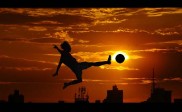The Secrets of Photographing Sunbursts
What’s more fun and exciting to do when it’s bright and sunny outside than having a picnic, going to the beach, taking a dip into the pool and doing other fun outdoor activities? But for photographers a bright and sunny day is a perfect time to grab their cameras and shoot away. Whether it’s portraits, architecture, an event, plants or animals they’re shooting, nothing beats a photo taken on a sunny day with the vast blue sky as its background. Another great thing to include in your photo is the sunburst, that magical beam of light will surely add an amazing effect to your photo. But how do you photograph sunbursts? Is there a special tool needed to capture sunbursts? Do you need to attach a certain filter or use a special lens? These questions will be answered as you read through this article.
How to photograph sunbursts?
There are lots of different ways and tips on photographing sunbursts. In case you still shoot in Jpeg format, the first step in shooting sunbursts is changing your camera format to RAW. Using RAW instead of Jpeg will make post-processing a lot easier. But we will discuss post-processing in the latter part of the article.
So how should you set your exposure when photographing sunbursts? I’ve tried and wasted so many shots on sunsets and sunrises trying to achieve this kind of shot:

Photo by: Douglas Brown
Good thing a friend taught me how to set my exposure settings to achieve a perfect sunburst photograph. One important tip on taking photos of sunbursts is to expose for the sky. If you don’t have a Speedlight or reflector you will probably have a slightly underexposed foreground. But this will help you capture the star-like beams of light coming from the sun, and will help you avoid having just a plain round ball of light. Set your camera to Aperture Priority mode and set your lens to a smaller opening – this ranges from f15 to f22. Setting your lens to a smaller opening will give you a much better sunburst shot.

Photo by: Sean Molin Photography

Photo by: Neil Armstrong2
If you’re taking a portrait and you plan on having the sky and sunburst as your background, I highly suggest that you use a reflector or a speedlight to avoid having an underexposed subject.
Some of you might wonder when is the best time to photograph sunbursts. If you think that the best time to capture a sunburst is at high noon, you are wrong. Shooting sunbursts during high noon may be harmful for your lens, so instead of shooting at high noon wait until the sun is at about 45 degrees. You can also try shooting through leaves or tree branches so that the sun won’t hit your lens directly.

Photo by: Toto_Ong
Post-Processing Sunburst Photos
If you happen to capture a photo that has underexposed foreground all you have to do is import it in Lightroom and adjust the exposure levels. If the foreground still appears underexposed hit the K button, choose the dodge brush and start brushing on your foreground.

Photo by: Arcreyes – [Ratamahatta]



